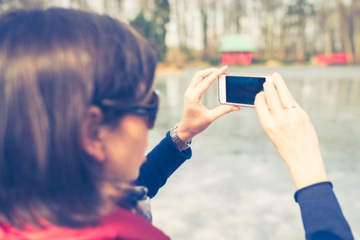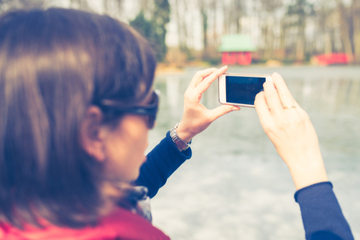
There’s a science behind what engages shoppers and gets them to purchase and new visual search tech implementations promise to exploit that and reinvent ecommerce as we know it.
A shopper’s decision to buy products is more influenced by the primal brain areas and less from the analytical side. Us humans are hard-wired to our emotions which spring from the same areas of the brain, the right side, that processes and reacts to visual stimulation. In the early days of mankind, it’s largely how our ancient ancestors survived in the wild.
Similar to Facebook’s emoticons it rolled out as “reactions” in 2016, our modern emotions emerge from four core feelings, happy, sad, afraid/surprised (“wow”), and angry/disgusted, based on research conducted by the Institute of Neuroscience and Psychology at the University of Glasgow.
Smart marketers can appeal to our right brains that communicate in feelings and respond to images that increase conversions and sales because people tend to act based on emotions. Most of the purchase decisions people make are emotional, not practical. Retail shopping therapy is, perhaps, an offshoot of this science-based truth.
When it comes to shopping, decision-making, and conversions, another experiment conducted by the George Washington University and UCLA, found that playing to the emotional side of our brains is a far better strategy than using too many facts and figures that appeal to the decision-making areas of the brain.
The researchers found that ads that use logical persuasion (for example, “this car gets 42 miles to the gallon”) scored lower for conversions than those that “seduced” people by circumventing “consumers’ conscious awareness by depicting a fun, vague or sexy scene”.
Visual search will revolutionize ecommerce and SEO
The rise of visual search is powered, in part, by people’s desire to discover products and brands, and it’s playing out now in the new trend of shopping on social media channels such as Instagram and Pinterest that’s spreading most quickly amongst millennials as the next big thing.
Yet, “creating technology that can understand images as quickly and effectively as the human mind is a huge undertaking”, wrote Adam Stetzer in a trend piece on visual search last year. “Visual identification is a natural ability made possible through a wonder of nerves, neurons and synapses. We can look at a picture, and in 13 milliseconds or less, know exactly what we’re seeing”.
Google is making rapid advancements tied to the increasingly visual nature of the search for ecommerce. For example, in early March it rolled out a new pilot program to digitally connect retailers and consumers, who can now make purchases from results of Google Image searches.
For the pilot’s launch, Google cited a figure that 50 percent of online shoppers said images of the product inspired them to purchase. Google is currently testing its “Showcase Shopping” ads on what it calls “a small percentage” of traffic with select retailers, surfacing on broad queries such as “home office ideas”, “shower tile designs”, and “abstract art”.
Certainly, the visual search trend will impact the programmatic ad industry’s innovations for future offerings. Advanced AI and computer imaging will be two core technologies that power dynamic personalization and highly customized ads that boost campaign performance tied to consumer’s visual search behaviors. For instance, it enables offering up winter jackets in the shopper’s favorite colors as fall approaches, or quickly serves up visually or stylistically complementary dining sets to match a new dining table or tablecloth search or purchase.
Adtech leaders’ R&D programs have already begun to focus on new AI-powered marketing innovations, including research and development from Facebook, Google, and Pinterest, and new strategic partnerships such as the one announced by Amazon and Snap last year.
Shoppable visual ads take off on social media platforms
The powerful combination of influencer marketing, using emotional buying triggers we’re hard-wired to respond to, and the highly visual nature of popular social channels such as Instagram and Pinterest have sparked the fast growth of shoppable ads on social media platforms.
Many industry watchers are betting that Instagram and Facebook will lead the pack here. Late last year, Salesforce predicted that Instagram will grow 3X faster than overall social-traffic boosts, citing data from Cowen & Company that 30 percent of internet users reported purchasing a product they discovered on Facebook or Instagram.
The overall trend of social media’s impact on purchase behavior is well-documented. As many as 76 percents of consumers have purchased a product they’ve seen in a brand’s social media post, per data from Curalate.
Influencer marketing and consumers’ purchase of products, as a result, is nothing new. For example, many kids who grew up in the 1970s and their parents bought Wheaties back then based on the cereal’s “Breakfast of Champions” campaign because they were inspired to be like Bruce Jenner after his decathlon triumph at the 1976 Montreal Olympics.
While the mediums have changed, and we can now click on ads and have products delivered within the same day, and be much more granular in terms of micro-influencers’ campaigns that pinpoint targets and conserve campaign budgets, the psychology of why it works is the same.
New platforms such as Shopify make it easy for brands and merchants of all kinds to create engaging, highly connected sites that are helping to energize the social aspects of the web.
Large companies such as Amazon, Pinterest, and Instagram have done an excellent job of figuring out consumer sentiment, emotions, and online behaviors. We’re getting much closer to narrowing down to a “segment of one“, a trend that many retailers today are focused on in order to increase the personalization of advertising and improve the experience for consumers so that promotional offers to purchase products become more like a personal shopper catering to them instead of a pushy salesperson who annoys them to the point of departing the store.
And if Pinterest is any indication with more than 600 million visual searches each month, and fact that image-based Pinterest ads have an 8.5 percent conversion rate, the role of visual search in helping to capture our attention, personalize the advertising experience, and seduce us to buy is here to stay as ecommerce and SEO evolve around it.
Gary Burtka is Vice President of U.S. operations at RTB House, a global company that provides retargeting technology for global brands worldwide. He can be found on Twitter .
Related reading
In Nov 2017, Venngage enjoyed 275,000 visitors a month from organic search traffic. Today (16 months later) it’s 900,000. Details of how they did it.
DuckDuckGo could be your new default search engine if you want to focus on privacy and security. What it’s like using it nowadays?
YouTube is not just a social media platform. It’s a powerful search engine for video content. Here’s how to make the most of its SEO potential.





